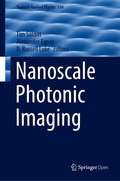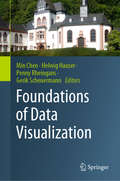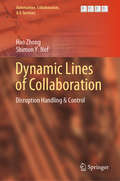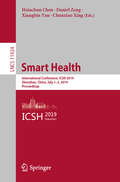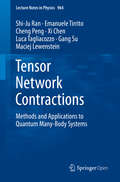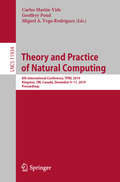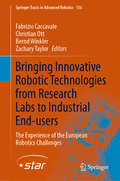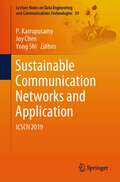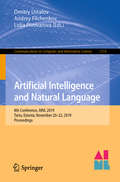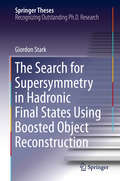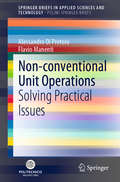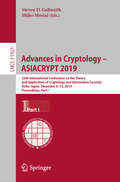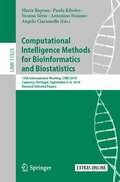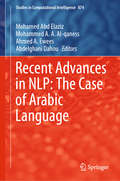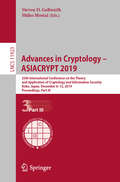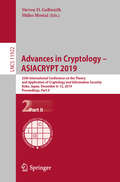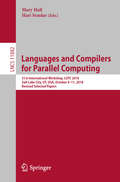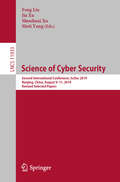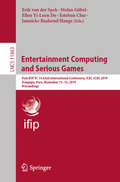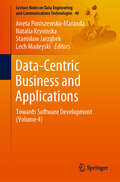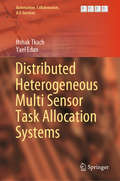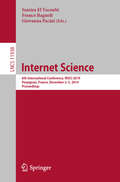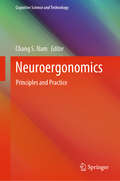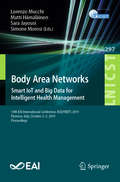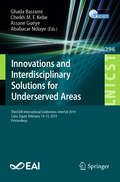- Table View
- List View
Nanoscale Photonic Imaging (Topics in Applied Physics #134)
by D. Russell Luke Tim Salditt Alexander EgnerThis open access book, edited and authored by a team of world-leading researchers, provides a broad overview of advanced photonic methods for nanoscale visualization, as well as describing a range of fascinating in-depth studies. Introductory chapters cover the most relevant physics and basic methods that young researchers need to master in order to work effectively in the field of nanoscale photonic imaging, from physical first principles, to instrumentation, to mathematical foundations of imaging and data analysis. Subsequent chapters demonstrate how these cutting edge methods are applied to a variety of systems, including complex fluids and biomolecular systems, for visualizing their structure and dynamics, in space and on timescales extending over many orders of magnitude down to the femtosecond range. Progress in nanoscale photonic imaging in Göttingen has been the sum total of more than a decade of work by a wide range of scientists and mathematicians across disciplines, working together in a vibrant collaboration of a kind rarely matched. This volume presents the highlights of their research achievements and serves as a record of the unique and remarkable constellation of contributors, as well as looking ahead at the future prospects in this field. It will serve not only as a useful reference for experienced researchers but also as a valuable point of entry for newcomers.
Foundations of Data Visualization
by Min Chen Helwig Hauser Penny Rheingans Gerik ScheuermannThis is the first book that focuses entirely on the fundamental questions in visualization. Unlike other existing books in the field, it contains discussions that go far beyond individual visual representations and individual visualization algorithms. It offers a collection of investigative discourses that probe these questions from different perspectives, including concepts that help frame these questions and their potential answers, mathematical methods that underpin the scientific reasoning of these questions, empirical methods that facilitate the validation and falsification of potential answers, and case studies that stimulate hypotheses about potential answers while providing practical evidence for such hypotheses. Readers are not instructed to follow a specific theory, but their attention is brought to a broad range of schools of thoughts and different ways of investigating fundamental questions. As such, the book represents the by now most significant collective effort for gathering a large collection of discourses on the foundation of data visualization. Data visualization is a relatively young scientific discipline. Over the last three decades, a large collection of computer-supported visualization techniques have been developed, and the merits and benefits of using these techniques have been evidenced by numerous applications in practice. These technical advancements have given rise to the scientific curiosity about some fundamental questions such as why and how visualization works, when it is useful or effective and when it is not, what are the primary factors affecting its usefulness and effectiveness, and so on. This book signifies timely and exciting opportunities to answer such fundamental questions by building on the wealth of knowledge and experience accumulated in developing and deploying visualization technology in practice.
Dynamic Lines of Collaboration: Disruption Handling & Control (Automation, Collaboration, & E-Services #6)
by Hao Zhong Shimon Y. NofThis book focuses on the systematic modeling of complex situations characterized by escalating disruptions, and on cycles of dynamic collaboration for the best handling of disruptions. What can we do about disruptive events and their cascading effects? Thanks to the evolution of intelligent technologies for interaction, communication, sharing, and collaboration, cyberspace is a rapidly expanding world. Our systems of machines, software services, and human organizations have become increasingly interdependent, in other words – networked. As a result, disruptions that initially affect only a small part of any network tend to escalate. At the same time, cyber solutions can support first responders and emergency handlers, enhancing their responsiveness and ability to collaborate with one another in controlling disruptions and preventing their escalation. In this book, we are chiefly interested in how effectively these collaborations can be supported and how we can further optimize such support. Solution guidelines for optimizing collaborations are illustrated with examples in various application domains: agricultural robotics, civil cyber-physical infrastructure, visual analytics, manufacturing automation, and supply chains. Open-source simulation tools are also provided to supplement the main content.
Smart Health: International Conference, ICSH 2019, Shenzhen, China, July 1–2, 2019, Proceedings (Lecture Notes in Computer Science #11924)
by Hsinchun Chen Daniel Zeng Xiangbin Yan Chunxiao XingThis book constitutes the thoroughly refereed conference proceedings of the International Conference for Smart Health, ICSH 2019, held in Shenzhen, China, in July 2019. The 34 full papers and 1 short papers presented were carefully reviewed and selected from 43 submissions. In this book a lively exchange and collaborations between the growing international smart health research scholars and communities has been introduced, and to advance our understanding about the technical, practical, economic, behavioral, and social issues center on smart health . The selected papers are organized into the following topics: Precision Medicine and Telehealth, Social, Psychosocial and Behavioral Determinants of Health, Data science, Analytics, Clinical and Business Intelligence, Clinical Informatics and Clinician Engagement.
Tensor Network Contractions: Methods and Applications to Quantum Many-Body Systems (Lecture Notes in Physics #964)
by Xi Chen Gang Su Maciej Lewenstein Shi-Ju Ran Emanuele Tirrito Cheng Peng Luca TagliacozzoTensor network is a fundamental mathematical tool with a huge range of applications in physics, such as condensed matter physics, statistic physics, high energy physics, and quantum information sciences. This open access book aims to explain the tensor network contraction approaches in a systematic way, from the basic definitions to the important applications. This book is also useful to those who apply tensor networks in areas beyond physics, such as machine learning and the big-data analysis. Tensor network originates from the numerical renormalization group approach proposed by K. G. Wilson in 1975. Through a rapid development in the last two decades, tensor network has become a powerful numerical tool that can efficiently simulate a wide range of scientific problems, with particular success in quantum many-body physics. Varieties of tensor network algorithms have been proposed for different problems. However, the connections among different algorithms are not well discussed or reviewed. To fill this gap, this book explains the fundamental concepts and basic ideas that connect and/or unify different strategies of the tensor network contraction algorithms. In addition, some of the recent progresses in dealing with tensor decomposition techniques and quantum simulations are also represented in this book to help the readers to better understand tensor network. This open access book is intended for graduated students, but can also be used as a professional book for researchers in the related fields. To understand most of the contents in the book, only basic knowledge of quantum mechanics and linear algebra is required. In order to fully understand some advanced parts, the reader will need to be familiar with notion of condensed matter physics and quantum information, that however are not necessary to understand the main parts of the book. This book is a good source for non-specialists on quantum physics to understand tensor network algorithms and the related mathematics.
Theory and Practice of Natural Computing: 8th International Conference, TPNC 2019, Kingston, ON, Canada, December 9–11, 2019, Proceedings (Lecture Notes in Computer Science #11934)
by Carlos Martín-Vide Geoffrey Pond Miguel A. Vega-RodríguezThis book constitutes the refereed proceedings of the 8th International Conference on Theory and Practice of Natural Computing, TPNC 2019, held in Kingston, ON, Canada, in December 2019. The 15 full papers presented in this book, together with two invited talk, were carefully reviewed and selected from 38 submissions. The papers are organized in topical sections named: Applications of Natural Computing; Evolutionary Computation; Genetic Algorithms, Swarm Intelligence, and Heuristics; Quantum Computing and Information.
Bringing Innovative Robotic Technologies from Research Labs to Industrial End-users: The Experience of the European Robotics Challenges (Springer Tracts in Advanced Robotics #136)
by Fabrizio Caccavale Zachary Taylor Christian Ott Bernd WinklerThis book presents the main achievements of the EuRoC (European Robotics Challenges) project, which ran from 1st January,2014 to 30th June 2018 and was funded by the European Union under the 7th Framework Programme. It describes not only the scientific and technological achievements of the project, but also the potential of the comparative challenge approach in robotics for knowledge advancement and technology transfer.
Sustainable Communication Networks and Application: ICSCN 2019 (Lecture Notes on Data Engineering and Communications Technologies #39)
by P. Karrupusamy Joy Chen Yong ShiThis book presents state-of-the-art theories and technologies and discusses developments in the two major fields: engineering and sustainable computing. In this modern era of information and communication technologies [ICT], there is a growing need for new sustainable and energy-efficient communication and networking technologies. The book highlights significant current and potential international research relating to theoretical and practical methods toward developing sustainable communication and networking technologies. In particular, it focuses on emerging technologies such as wireless communications, mobile networks, Internet of things [IoT], sustainability, and edge network models. The contributions cover a number of key research issues in software-defined networks, blockchain technologies, big data, edge/fog computing, computer vision, sentiment analysis, cryptography, energy-efficient systems, and cognitive platforms.
Artificial Intelligence and Natural Language: 8th Conference, AINL 2019, Tartu, Estonia, November 20–22, 2019, Proceedings (Communications in Computer and Information Science #1119)
by Dmitry Ustalov Andrey Filchenkov Lidia PivovarovaThis book constitutes the refereed proceedings of the 8th Conference on Artificial Intelligence and Natural Language, AINL 2019, held in Tartu, Estonia, in November 2019. The 10 revised full papers and 2 short papers were carefully reviewed and selected from 34 submissions. The papers are organized according to the following topics: data acquisition and annotation; human-computer interaction; statistical natural language processing; neural language models.
The Search for Supersymmetry in Hadronic Final States Using Boosted Object Reconstruction (Springer Theses)
by Giordon StarkThis thesis represents one of the most comprehensive and in-depth studies of the use of Lorentz-boosted hadronic final state systems in the search for signals of Supersymmetry conducted to date at the Large Hadron Collider. A thorough assessment is performed of the observables that provide enhanced sensitivity to new physics signals otherwise hidden under an enormous background of top quark pairs produced by Standard Model processes. This is complemented by an ingenious analysis optimization procedure that allowed for extending the reach of this analysis by hundreds of GeV in mass of these hypothetical new particles. Lastly, the combination of both deep, thoughtful physics analysis with the development of high-speed electronics for identifying and selecting these same objects is not only unique, but also revolutionary. The Global Feature Extraction system that the author played a critical role in bringing to fruition represents the first dedicated hardware device for selecting these Lorentz-boosted hadronic systems in real-time using state-of-the-art processing chips and embedded systems.
Non-conventional Unit Operations: Solving Practical Issues (SpringerBriefs in Applied Sciences and Technology)
by Flavio Manenti Alessandro Di PretoroThis volume presents both methodologies and numerical applications for the design of non-conventional unit operations in chemical processes and plants, which are rarely studied in depth at an academic level but have wide applications in the industrial sector. The first part discusses the design, comparison and optimization of heating and cooling operations that are different from simple heat exchange. The second and larger part offers a brief but effective overview of non-conventional separation processes, mainly focusing on the heterogeneous phases. Based on sample case studies, it extrapolates the process model equations and includes the numerical solution in order to provide a straightforward application example. The end of each chapter features a C++ code implementation to solve the ODE or nonlinear equations system using the BzzMath library.
Advances in Cryptology – ASIACRYPT 2019: 25th International Conference on the Theory and Application of Cryptology and Information Security, Kobe, Japan, December 8–12, 2019, Proceedings, Part I (Lecture Notes in Computer Science #11921)
by Steven D. Galbraith Shiho MoriaiThe three-volume set of LNCS 11921,11922, and 11923 constitutes the refereed proceedings of the 25th International Conference on the Theory and Applications of Cryptology and Information Security, ASIACRYPT 2019, held in Kobe, Japan, in December 2019. The 71 revised full papers presented were carefully reviewed and selected from 307 submissions. They are organized in topical sections on Lattices; Symmetric Cryptography; Isogenies; Obfuscation; Multiparty Computation; Quantum; E-cash and Blockchain; Codes; Authenticated Encryption; Multilinear Maps; Homomorphic Encryption; Combinatorial Cryptography; Signatures; Public Key Encryption; Side Channels; Functional Encryption; Zero Knowledge.
Computational Intelligence Methods for Bioinformatics and Biostatistics: 15th International Meeting, CIBB 2018, Caparica, Portugal, September 6–8, 2018, Revised Selected Papers (Lecture Notes in Computer Science #11925)
by Maria Raposo Paulo Ribeiro Angelo Ciaramella Susana Sério Antonino StaianoThis book constitutes the thoroughly refereed post-conference proceedings of the 15th International Meeting on Computational Intelligence Methods for Bioinformatics and Biostatistics., CIBB 2018, held in Caparica, Portugal, in September 2018. The 32 revised full papers were carefully reviewed and selected from 51 submissions. The papers present current trends at the edge of computer and life sciences, the application of computational intelligence to a system and synthetic biology and the consequent impact on innovative medicine were presented. Theoretical and experimental biologists also presented novel challenges and fostered multidisciplinary collaboration aiming to blend theory and practice, where the founding theories of the techniques used for modelling and analyzing biological systems are investigated and used for practical applications and the supporting technologies.
Recent Advances in NLP: The Case of Arabic Language (Studies in Computational Intelligence #874)
by Mohamed Abd Elaziz Mohammed A. A. Al-qaness Ahmed A. Ewees Abdelghani DahouIn light of the rapid rise of new trends and applications in various natural language processing tasks, this book presents high-quality research in the field. Each chapter addresses a common challenge in a theoretical or applied aspect of intelligent natural language processing related to Arabic language. Many challenges encountered during the development of the solutions can be resolved by incorporating language technology and artificial intelligence.The topics covered include machine translation; speech recognition; morphological, syntactic, and semantic processing; information retrieval; text classification; text summarization; sentiment analysis; ontology construction; Arabizi translation; Arabic dialects; Arabic lemmatization; and building and evaluating linguistic resources.This book is a valuable reference for scientists, researchers, and students from academia and industry interested in computational linguistics and artificial intelligence, especially for Arabic linguistics and related areas.
Advances in Cryptology – ASIACRYPT 2019: 25th International Conference on the Theory and Application of Cryptology and Information Security, Kobe, Japan, December 8–12, 2019, Proceedings, Part III (Lecture Notes in Computer Science #11923)
by Steven D. Galbraith Shiho MoriaiThe three-volume set of LNCS 11921,11922, and 11923 constitutes the refereed proceedings of the 25th International Conference on the Theory and Applications of Cryptology and Information Security, ASIACRYPT 2019, held in Kobe, Japan, in December 2019. The 71 revised full papers presented were carefully reviewed and selected from 307 submissions. They are organized in topical sections on Lattices; Symmetric Cryptography; Isogenies; Obfuscation; Multiparty Computation; Quantum; E-cash and Blockchain; Codes; Authenticated Encryption; Multilinear Maps; Homomorphic Encryption; Combinatorial Cryptography; Signatures; Public Key Encryption; Side Channels; Functional Encryption; Zero Knowledge.
Advances in Cryptology – ASIACRYPT 2019: 25th International Conference on the Theory and Application of Cryptology and Information Security, Kobe, Japan, December 8–12, 2019, Proceedings, Part II (Lecture Notes in Computer Science #11922)
by Steven D. Galbraith Shiho MoriaiThe three-volume set of LNCS 11921,11922, and 11923 constitutes the refereed proceedings of the 25th International Conference on the Theory and Applications of Cryptology and Information Security, ASIACRYPT 2019, held in Kobe, Japan, in December 2019. The 71 revised full papers presented were carefully reviewed and selected from 307 submissions. They are organized in topical sections on Lattices; Symmetric Cryptography; Isogenies; Obfuscation; Multiparty Computation; Quantum; E-cash and Blockchain; Codes; Authenticated Encryption; Multilinear Maps; Homomorphic Encryption; Combinatorial Cryptography; Signatures; Public Key Encryption; Side Channels; Functional Encryption; Zero Knowledge.
Languages and Compilers for Parallel Computing: 31st International Workshop, LCPC 2018, Salt Lake City, UT, USA, October 9–11, 2018, Revised Selected Papers (Lecture Notes in Computer Science #11882)
by Mary Hall Hari SundarThis book constitutes the thoroughly refereed post-conference proceedings of the 31st International Workshop on Languages and Compilers for Parallel Computing, LCPC 2018, held in Salt Lake City, UT, USA, in October 2018. The 14 revised full papers were carefully reviewed and selected from 26 submissions. Specific topics are compiling for parallelism and parallel compilers, static, dynamic, and adaptive optimization of parallel programs, parallel programming models and languages, formal analysis and verification of parallel programs, parallel runtime systems and libraries, performance analysis and debugging tools for concurrency and parallelism, parallel algorithms and concurrent data structures, parallel applications, synchronization and concurrency control, software engineering for parallel programs, fault tolerance for parallel systems, and parallel programming and compiling for heterogeneous systems.
Science of Cyber Security: Second International Conference, SciSec 2019, Nanjing, China, August 9–11, 2019, Revised Selected Papers (Lecture Notes in Computer Science #11933)
by Feng Liu Moti Yung Shouhuai Xu Jia XuThis book constitutes the proceedings of the Second International Conference on Science of Cyber Security, SciSec 2019, held in Nanjing, China, in August 2019. The 20 full papers and 8 short papers presented in this volume were carefully reviewed and selected from 62 submissions. These papers cover the following subjects: Artificial Intelligence for Cybersecurity, Machine Learning for Cybersecurity, and Mechanisms for Solving Actual Cybersecurity Problems (e.g., Blockchain, Attack and Defense; Encryptions with Cybersecurity Applications).
Entertainment Computing and Serious Games: First IFIP TC 14 Joint International Conference, ICEC-JCSG 2019, Arequipa, Peru, November 11–15, 2019, Proceedings (Lecture Notes in Computer Science #11863)
by Erik van der Spek Stefan Göbel Ellen Yi-Luen Do Esteban Clua Jannicke Baalsrud HaugeThis book constitutes the refereed proceedings of the First IFIP TC 14 Joint International Conference on Entertainment Computing and Serious Games, ICEC-JCSG 2019, held in Arequipa, Peru, in November 2019.The 26 full papers, 5 short papers, and 16 poster, demonstration, and workshop papers presented were carefully reviewed and selected from 88 submissions. They cover a large range of topics at the multidisciplinary intersection of design, art, entertainment, interaction, computing, psychology, and numerous serious application domains. The papers are organized in the following topical sections: mixed reality; virtual reality; entertainment algorithms; game design and development; interaction technologies; measurement and effects; and serious game applications.
Data-Centric Business and Applications: Towards Software Development (Volume 4) (Lecture Notes on Data Engineering and Communications Technologies #40)
by Aneta Poniszewska-Marańda Natalia Kryvinska Stanisław Jarząbek Lech MadeyskiThis book explores various aspects of software creation and development as well as data and information processing. It covers relevant topics such as business analysis, business rules, requirements engineering, software development processes, software defect prediction, information management systems, and knowledge management solutions. Lastly, the book presents lessons learned in information and data management processes and procedures.
Distributed Heterogeneous Multi Sensor Task Allocation Systems (Automation, Collaboration, & E-Services #7)
by Itshak Tkach Yael EdanToday’s real-world problems and applications in sensory systems and target detection require efficient, comprehensive and fault-tolerant multi-sensor allocation. This book presents the theory and applications of novel methods developed for such sophisticated systems. It discusses the advances in multi-agent systems and AI along with collaborative control theory and tools. Further, it examines the formulation and development of an allocation framework for heterogeneous multi-sensor systems for various real-world problems that require sensors with different performances to allocate multiple tasks, with unknown a priori priorities that arrive at unknown locations at unknown time. It demonstrates how to decide which sensor to allocate to which tasks when and where. Lastly, it explains the reliability and availability issues of task allocation systems, and includes methods for their optimization.The presented methods are explained, measured, and evaluated by extensive simulations, and the results of these simulations are presented in this book. This book is an ideal resource for academics, researchers and graduate students as well as engineers and professionals and is relevant for various applications such as sensor network design, multi-agent systems, task allocation, target detection, and team formation.
Internet Science: 6th International Conference, INSCI 2019, Perpignan, France, December 2–5, 2019, Proceedings (Lecture Notes in Computer Science #11938)
by Samira El Yacoubi Franco Bagnoli Giovanna PaciniThis book constitutes the proceedings of the 6th International Conference on Internet Science held in Perpignan, France, in December 2019. The 30 revised full papers presented were carefully reviewed and selected from 45 submissions. The papers detail a multidisciplinary understanding of the development of the Internet as a societal and technological artefact which increasingly evolves with human societies.
Neuroergonomics: Principles and Practice (Cognitive Science and Technology)
by Chang S. NamThis book sums up key research findings, and theoretical and technological advances having a direct bearing on neuroergonomics. Neuroergonomics is an emerging area whose Neuroergonomics is an emerging area that is collectively defined as the study of human brain function and behaviour in relation to behavioural performance in natural environments and everyday settings. It helps readers to understand neural mechanisms of human cognition in the context of human interaction with complex systems, as well as understanding the change of perception, decision-making and training in humans. The authors give new insights into augmenting human performance, reflecting upon the opportunities provided through neuroergonomics research and development. Computer systems acting on data from behavioural-output, physiological, and neurological sensing technologies are used to determine the user’s cognitive state and adapt the systems to change, support, and monitor human cognition. Various domains and case studies delve into the field of neuroergonomics in detail. These include, but are not limited to:an evaluation of technologies in health, workplace, and education settings, to show the different impacts of neuroergonomics in everyday lives;assessment of real-time cognitive measures;dynamic casual interactions between inhibition and updating functions, through analysis of behavioral, neurophysiological and effective connectivity metrics; and applications in human performance modelling and assessment of mental workload, showing the reader how to train and improve working memory capacity.Neuroergonomics: Principles and Practice provides academic practitioners and graduate students with a single go-to handbook that will be of significant assistance in research associated with human factors and ergonomics, human-computer interaction, human-systems engineering and cognitive neuroscience.
Body Area Networks: 14th EAI International Conference, BODYNETS 2019, Florence, Italy, October 2-3, 2019, Proceedings (Lecture Notes of the Institute for Computer Sciences, Social Informatics and Telecommunications Engineering #297)
by Lorenzo Mucchi Matti Hämäläinen Sara Jayousi Simone MorosiThis book constitutes the refereed post-conference proceedings of the 14th EAI International Conference on Body Area Networks, BodyNets 2019, held in Florence, Italy, in October 2019. The 27 papers presented were selected from 54 submissions and issue new technologies to provide trustable measuring and communications mechanisms from the data source to medical health databases. Wireless body area networks (WBAN) are one major element in this process. Not only on-body devices but also technologies providing information from inside a body are in the focus of this conference. Dependable communications combined with accurate localization and behavior analysis will benefit WBAN technology and make the healthcare processes more effective.
Innovations and Interdisciplinary Solutions for Underserved Areas: Third EAI International Conference, InterSol 2019, Cairo, Egypt, February 14–15, 2019, Proceedings (Lecture Notes of the Institute for Computer Sciences, Social Informatics and Telecommunications Engineering #296)
by Ghada Bassioni Cheikh M. F. Kebe Assane Gueye Ababacar NdiayeThis book constitutes the refereed post-conference proceedings of the Third EAI International Conference on Innovations and Interdisciplinary Solutions for Underserved Areas, InterSol 2019, and the 8th Conference on Research in Computer Science and its Applications, CNRIA 2019, held in Saint-Louis, Senegal, in April 2019. The 16 papers presented were selected from 34 submissions and issue different problems in underserved and unserved areas. They face problems in almost all sectors such as energy, water, communication, climate, food, education, transportation, social development, and economic growth.
